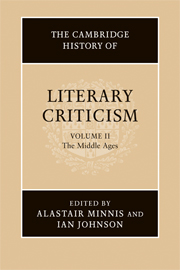Book contents
- Frontmatter
- Introduction
- I THE LIBERAL ARTS AND THE ARTS OF LATIN TEXTUALITY
- 1 Grammatica and literary theory
- 2 The arts of poetry and prose
- 3 The arts of letter-writing
- 4 The arts of preaching
- II THE STUDY OF CLASSICAL AUTHORS
- III TEXTUAL PSYCHOLOGIES: IMAGINATION, MEMORY, PLEASURE
- IV VERNACULAR CRITICAL TRADITIONS: THE EARLY MIDDLE AGES
- V VERNACULAR CRITICAL TRADITIONS: THE LATE MIDDLE AGES
- VI LATIN AND VERNACULAR IN ITALIAN LITERARY THEORY
- VII BYZANTINE LITERARY THEORY AND CRITICISM
- Bibliography
- Index
- References
2 - The arts of poetry and prose
from I - THE LIBERAL ARTS AND THE ARTS OF LATIN TEXTUALITY
Published online by Cambridge University Press: 28 March 2008
- Frontmatter
- Introduction
- I THE LIBERAL ARTS AND THE ARTS OF LATIN TEXTUALITY
- 1 Grammatica and literary theory
- 2 The arts of poetry and prose
- 3 The arts of letter-writing
- 4 The arts of preaching
- II THE STUDY OF CLASSICAL AUTHORS
- III TEXTUAL PSYCHOLOGIES: IMAGINATION, MEMORY, PLEASURE
- IV VERNACULAR CRITICAL TRADITIONS: THE EARLY MIDDLE AGES
- V VERNACULAR CRITICAL TRADITIONS: THE LATE MIDDLE AGES
- VI LATIN AND VERNACULAR IN ITALIAN LITERARY THEORY
- VII BYZANTINE LITERARY THEORY AND CRITICISM
- Bibliography
- Index
- References
Summary
In medieval terminology the Latin word ars (plural: artes) denoted a body of principles relating to a specific activity such as painting, music, preaching or writing. By extension the term was also used for a written treatise on the subject of a particular art. For example the Ars nova of Philippe de Vitry, written at Paris about 1320, lays out the principles for musical notation which were dominant during the fourteenth century. The term ‘art’ or ars when applied to such a treatise indicates a discussion of what the ancient Greeks would have called techné – ‘technique’ or ‘craft’ – rather than an abstract or theoretical discussion of a subject.
Medieval writers had access to three major types of such artes dealing with separate kinds of literary composition. The first type was the school art, usually called an Ars poetriae but teaching how to compose both poetry and prose regardless of genre. The second was the Ars dictaminis, or art of letter-writing (on which see Chapter 3 below), while the third was the Ars praedicandi, or the art of preaching (see Chapter 4). All three types deal with specific techniques for finding ideas, arranging them, and putting them into verbal language for transmission to an audience of readers or hearers.
At the outset it may be recalled that medieval language-use involved a much greater oral element than is common nowadays. Poems were written to be read aloud, just as letters were often written to be heard and therefore involved careful attention to aural rhythms in their prose; the audience's experience of the sermon was of course primarily aural.
- Type
- Chapter
- Information
- The Cambridge History of Literary Criticism , pp. 42 - 67Publisher: Cambridge University PressPrint publication year: 2005
References
- 1
- Cited by

